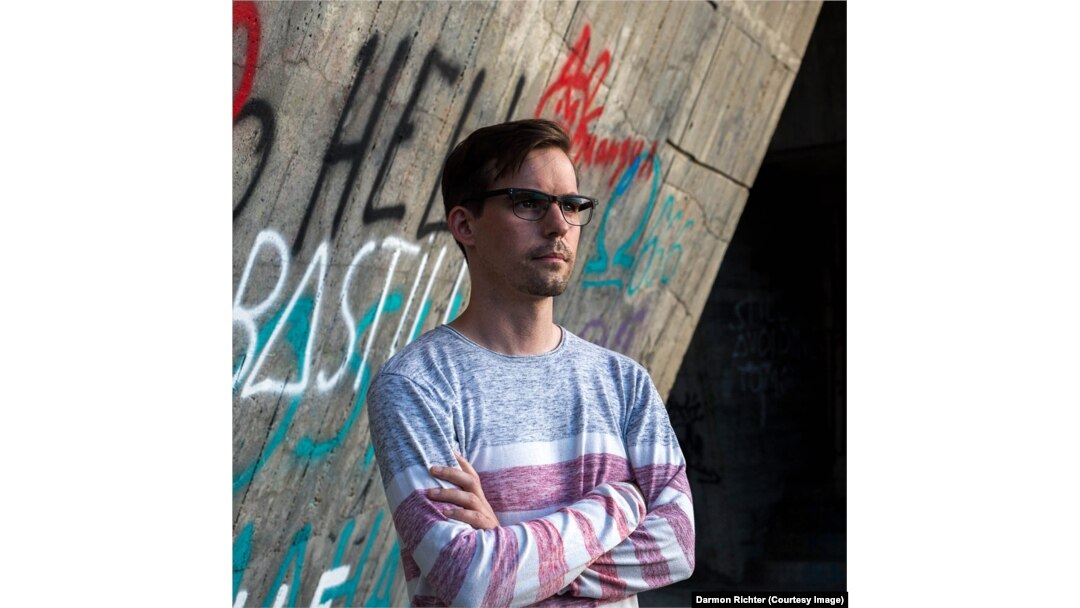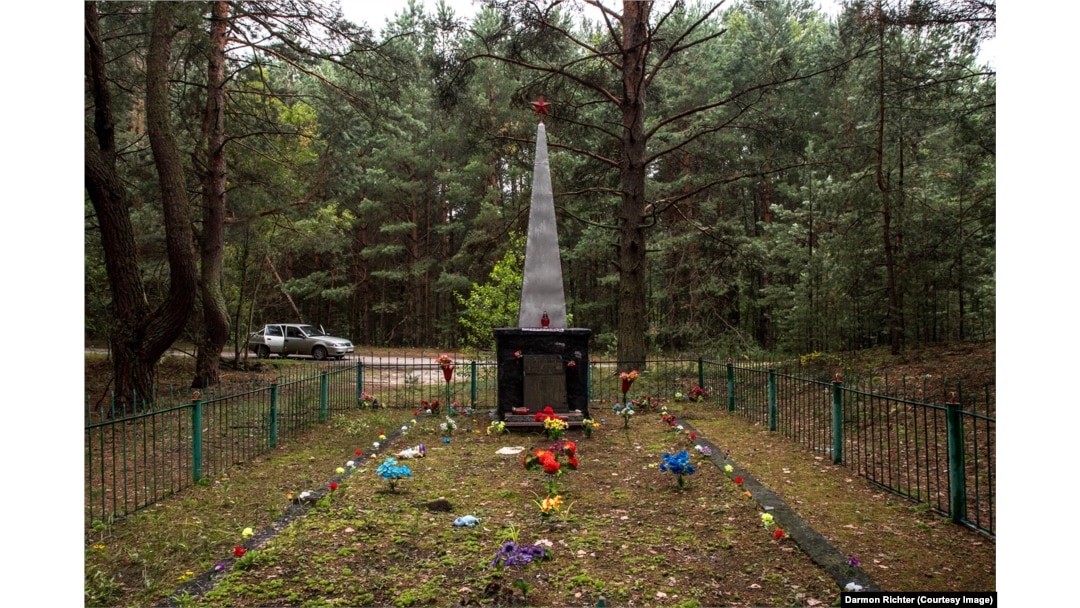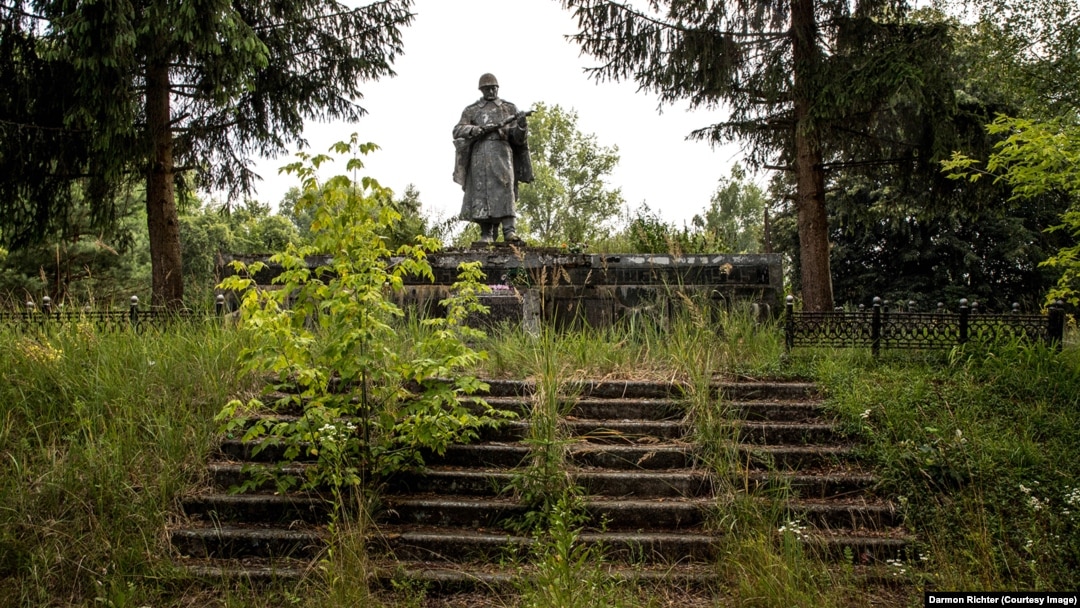When Darmon Richter and three friends headed into the closed wilderness around Chernobyl in the summer of 2018, they took two essential items: A Soviet-era map that listed all of the area’s World War II memorials, and a chainsaw.
Richter, a British-born photographer and writer, explained to RFE/RL that “many of the roads on that map were no longer there, having been blocked or eroded away over the years. There was one village where fallen trees had completely barred the road going in.”

Darmon Richter, a British writer and photographer who is known for extensive exploration and research of the Chernobyl exclusion zone.
After firing up the chainsaw, the group was able to buzz a path to the long-abandoned settlement. Near the village, Richter was able to capture one of the scores of World War II memorials that remain in Ukraine and Belarus's radiation-tainted exclusion zone. The adventurer has made it his mission over the past eight years to photograph and research the poignant monuments. He agreed to share several of his images with RFE/RL.

Novoshepelychi, Ukraine. An obelisk with the inscription: “Here were buried residents of neighboring villages who died at the hands of fascist invaders during the Great Patriotic War. 1941-1945.” The village of Novoshepelychi has largely disappeared into the forest after being heavily contaminated during the nuclear disaster, but the memorial appears to be well tended by former residents.
Richter says in many areas of the exclusion zone Ukrainian authorities allow former residents to visit their lost villages once every year.
“In the weekend after Easter, these people drive back to their former homes to visit their monuments, churches, and the graves of loved ones. So often they’ll use this opportunity to maintain graves and memorials, leaving plastic flowers there, too.”
Krasne, Ukraine. A statue of a soldier with the dedication: “No one is forgotten, nothing is forgotten. Eternal glory to the soldier-villagers who died on the fronts of the Great Patriotic War. 1941-1945.” In the Soviet Union, World War II was known as the Great Patriotic War.
The Briton describes “a strange but somehow beautiful sight to drive through a completely derelict village, all the houses in the process of collapsing, then at its center find a war memorial with mown grass around it and colorful flowers strewn at its feet.”
Zherdnaye, Belarus. The inscription on the black granite memorial reads "1941-1945. The grateful homeland will forever be proud of the heroic deeds of its brave sons and daughters.”
Richter says several monuments on the historic map he used have disappeared from their plinths. Many areas of the exclusion zone were heavily looted in the wake of the 1986 nuclear explosion and some of the region’s war memorials were made out of valuable metals.
Rudnya Illinetska, Ukraine. This painted wooden monument marks the place where a Soviet fighter pilot was downed during the war. The original inscription reads: “Passerby! Bend your head before the grave where the remains lie of an unknown Soviet pilot killed on October 4, 1943, when our homeland was liberated from German fascist invaders.”
The pilot’s identity was apparently later discovered. A more recent plaque at the site adds: “Junior Lieutenant Safar Abutalybogly Kurbanov: 1923-1943.”
Monument to Pasha Osidach. Chernobyl, Ukraine.
Pasha Osidach served as a messenger for bands of partisans during the Nazi occupation of the area around Chernobyl. Pasha reportedly hid the vital communications in the braids of her long hair. In 1943, Nazi forces discovered her with such messages and they tortured her before reportedly burying her alive, aged 21.
Pirki, Belarus. Inside this freshly painted picket fence are several military graves. Beneath the kneeling soldier a plaque declares “Eternal glory to the heroes who fell in the battles for the freedom and independence of our homeland.”
Not all of the monuments in the exclusion zone are well maintained, sometimes for obvious reasons.
Yaniv, Ukraine. This monument commemorating battles fought for the Yaniv village was directly downwind of the 1986 nuclear disaster in an area now known as the "Red Forest."
Today this spot remains one of the most radioactive places on Earth.
Tovstyy Lis, Ukraine. This badly damaged memorial is barely held together by the reinforcing metal inside after being nearly destroyed by a bushfire.
In 2005, the Ukrainian poet Lina Kostenko wrote about this statue: “In Tovstyy Lis there’s a young boy between two trees. When there was a fire, the trees were on fire, too, and the monument got so hot its chest cracked open…like in a war…. We found an old can, filled it with water, plucked some small white flowers, and left them for the soldier.”
Opachychi, Ukraine. In 2002, this monument was modified with the addition of a cross, which was affixed onto the Soviet star.
Richter told RFE/RL his expeditions to find such memorials was a powerful reminder of the layers of history in the forests around Chernobyl. “This region lost more people to the war than it did to the Chernobyl disaster -- I think a lot of outsiders tend to forget the historic hardships of this place. They hear Chernobyl and all they picture is the disaster in 1986. But spending time with these monuments was a sobering reminder of how much these communities had already been through before that point.”
Teremtsi, Ukraine. This monument was built on the site of a Nazi-run prison where several local partisans were executed. An engraved poem reads: “In the memory of the stone/In the memory of the heart/Each of these names will never be erased.”
While Richter was photographing this memorial, two elderly women who had returned to the village after the 1986 evacuation heard Richter’s car arrive and went to investigate. The photographer says “they noticed my interest in the monument and immediately began sharing their personal recollections of the events the monument described. They were both young girls when the Nazis occupied their village.”
Poliske, Ukraine. A simple dedication on this overgrown memorial reads: “1941-1945. We remember.”
Most of the places in Richter's images are accessible in a guided tour, but there is a simple reason why so few sites such as these have been documented. “Chernobyl is the size of a country, and most tourists who go spend only one or two days there,” the photographer says. “So of course they visit the big, iconic locations -- the power plant, the cooling towers.... Meanwhile, all around, there are dozens of villages spread over a vast area that rarely gets visited by anyone. It’s not that you can’t go to them, but tour companies generally assume that these places won’t be interesting for foreigners, and foreigners aren’t going to ask to visit a place if they don’t know it exists!”
Horodyshche, Ukraine. A memorial obelisk next to the edge of the village. Its inscription reads: “Stop, bow low! They gave their lives for your happiness! Eternal glory to the soldier-villagers who died on the fronts of the Great Patriotic War. 1941–1945.”
Rozsokha, Ukraine. Sixty-eight men from this village died fighting in the war. This monument was built over a mass grave for those who died here. The banner behind the statue reads: "No one is forgotten, nothing is forgotten."
Richter says his hope for the project is that “by putting faces to the names of these lost villages, it might help to encourage people to think of the Chernobyl region as more than just the place where a power plant blew up in 1986.”
Written by Amos Chapple based on reporting by Darmon Richter


